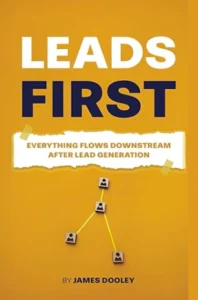Imagine waking up each day knowing that your business has a steady, predictable stream of potential customers coming in—without constantly chasing them. This is the promise of Leads First: Everything Flows Downstream After Lead Generation, James Dooley’s playbook for transforming lead generation into a systemized powerhouse that fuels sustainable business growth. But does the book deliver on its bold claims?
In this in-depth review, we’ll break down Dooley’s key strategies, assess the book’s strengths and weaknesses, and explore whether Leads First truly stands out in the crowded landscape of marketing and sales literature. If you’re a business owner, marketer, or entrepreneur struggling to generate high-quality leads, this review will help you decide whether this book belongs on your must-read list.

Why Lead Generation Matters More Than Ever
Every business thrives or dies based on its ability to attract and convert leads. Yet, many businesses approach lead generation sporadically—relying on word-of-mouth, inconsistent advertising, or outdated tactics that no longer work in the digital age. James Dooley argues that this is a recipe for stagnation.
In Leads First, Dooley presents a compelling case for prioritizing lead generation as the foundation of business success. He asserts that most companies focus too much on short-term marketing tactics while neglecting the bigger picture: creating a system that continuously attracts and nurtures potential customers. His central philosophy? “Everything flows downstream after lead generation.” In other words, if you get this step right, sales, customer retention, and business growth naturally follow.
The Core Lessons from Leads First
The book is structured around the idea that businesses must move from unpredictable, hit-or-miss marketing efforts to a repeatable, scalable system. Dooley provides a roadmap for achieving this, with several standout lessons:
1. Building a Lead Generation System
Dooley stresses that lead generation is not a one-time effort—it’s a system that should function like a well-oiled machine. He offers a step-by-step breakdown of how to build such a system, focusing on:
- Identifying the ideal audience and their specific needs.
- Creating lead magnets that attract high-quality prospects.
- Using automation to nurture leads and move them down the sales funnel efficiently.
One of the book’s biggest strengths is its emphasis on strategy over guesswork. Instead of advocating for quick hacks or trendy marketing tricks, Dooley provides a framework that businesses can adapt to their unique models.
2. The AI Advantage in Lead Generation
Artificial intelligence is reshaping marketing, and Leads First doesn’t shy away from this reality. Dooley highlights how AI-powered tools can automate lead scoring, personalize outreach, and predict which prospects are most likely to convert. If your business isn’t leveraging AI yet, this book makes a strong case for why you should start.
3. The Psychology of Converting Leads into Loyal Customers
Generating leads is only half the battle—the real challenge is turning those leads into paying customers. Dooley explains that the conversion process hinges on psychology. By understanding how potential buyers think, businesses can craft messaging that resonates, build trust, and eliminate friction in the buying journey.
Some key strategies he discusses include:
- Using social proof and testimonials to establish credibility.
- Creating urgency without being overly aggressive.
- Crafting personalized follow-ups to re-engage leads who hesitate.
Where Leads First Shines
While there’s no shortage of books on sales and marketing, Leads First stands out in several ways:
Actionable Strategies Over Theory
Many business books suffer from being overly theoretical, but Dooley’s background as a practitioner ensures that this book is grounded in real-world experience. He provides detailed, practical steps for implementing each concept, making it easy for readers to apply the ideas immediately.
Emphasis on Long-Term Success
Rather than focusing on quick wins, Leads First encourages readers to think long-term. The strategies presented are designed to create a sustainable lead-generation system rather than relying on short-lived tactics that quickly lose effectiveness.
AI and Modern Marketing Integration
Dooley’s discussion of AI and data-driven marketing sets this book apart from traditional lead-generation guides. He acknowledges the evolving digital landscape and provides readers with forward-thinking strategies to stay ahead of the curve.
Potential Drawbacks and Limitations
Despite its strengths, Leads First isn’t without its limitations. Some areas where the book could improve include:
Lack of Industry-Specific Case Studies
While Dooley provides compelling examples, many are drawn from his own experiences rather than a diverse range of industries. Readers in niche markets may need to adapt the strategies to fit their specific contexts.
AI Implementation Can Be Complex
Although the book champions AI as a game-changer, some business owners may find its implementation daunting. While Dooley touches on AI-driven lead generation, more step-by-step guidance on tools and execution would have been valuable.
Heavy Focus on Dooley’s Perspective
The book leans heavily on Dooley’s personal insights, which, while valuable, might not resonate with every reader. Some businesses may prefer a broader perspective that includes insights from multiple experts.
How Leads First Compares to Other Lead Generation Books
For those familiar with marketing literature, Leads First has elements that overlap with books like Russell Brunson’s Dotcom Secrets or Chet Holmes’ The Ultimate Sales Machine. However, Dooley’s work differentiates itself by placing lead generation at the center of all business growth strategies and integrating AI-driven insights.
Unlike books that focus solely on sales funnels or conversion tactics, Leads First emphasizes the entire lifecycle of a lead—from attraction to long-term customer retention. This makes it a well-rounded resource for businesses looking to overhaul their marketing systems.
Final Verdict: Should You Read Leads First?
If you’re struggling to build a consistent pipeline of leads or find yourself relying on unpredictable marketing tactics, Leads First offers a roadmap to transform your approach. Its emphasis on sustainable systems, AI integration, and customer psychology makes it a valuable read for entrepreneurs and marketers alike.
However, if you’re looking for a book with deep industry-specific insights or a technical guide to AI-driven marketing, you may find some aspects lacking. That said, the principles in this book apply across industries, making it a solid investment for anyone serious about growth.
Ultimately, the biggest takeaway from Leads First is simple: When you prioritize lead generation, everything else in your business falls into place. And that’s a lesson worth learning.
Want to see how these strategies work in practice? Grab a copy of Leads First and start building your system today.

